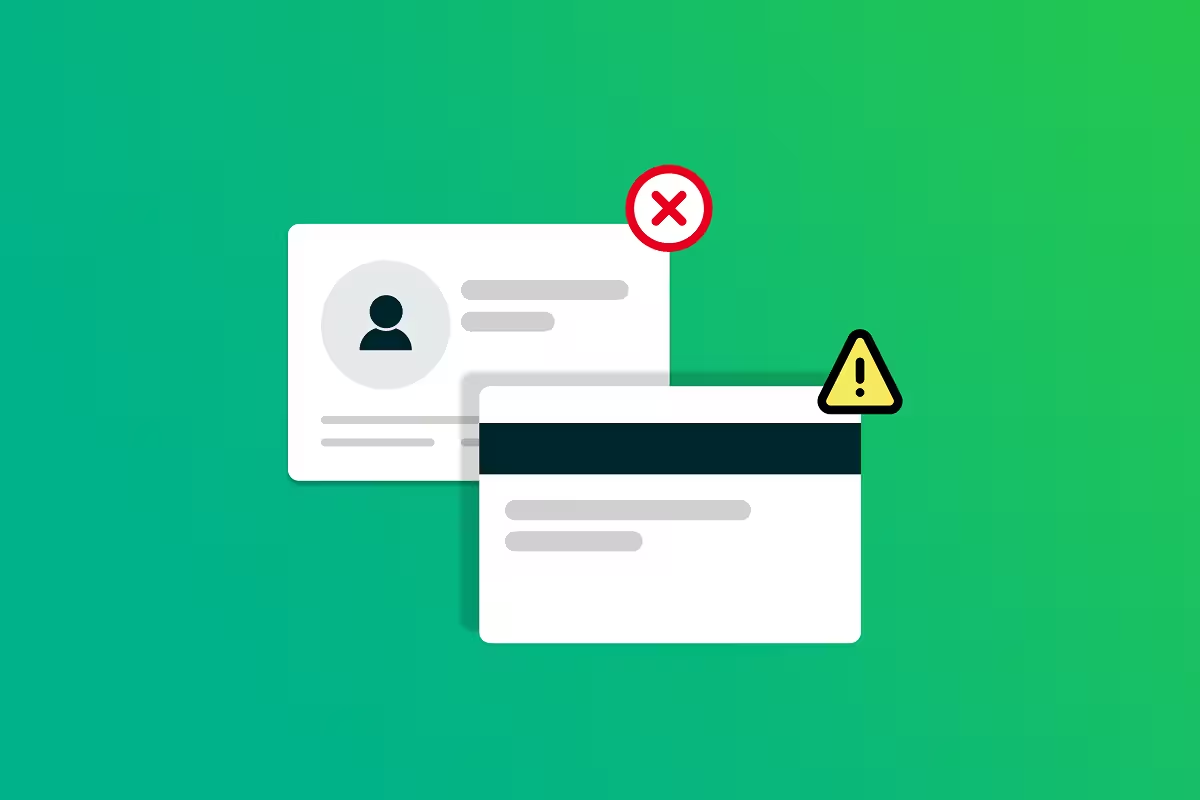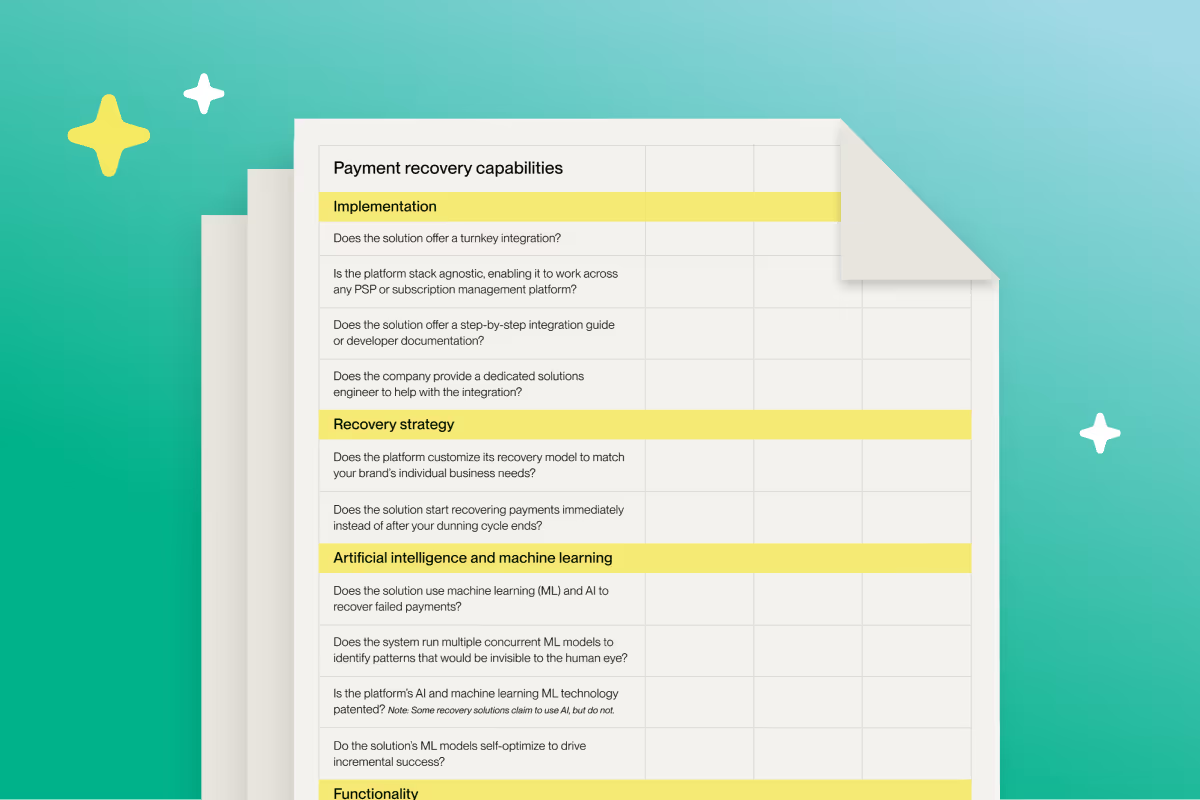
Understanding involuntary churn: a complete guide
While most subscription companies focus their retention efforts on preventing voluntary cancellations, a more insidious problem lurks in the background—involuntary churn.
This type of customer loss doesn't happen because subscribers are dissatisfied with your product or service. Instead, it occurs when legitimate payment transactions fail, causing active customers to churn despite their intention to continue.
But what can you do about it? It’s a good question that we have the answer to. This guide will walk you through everything you need to know about involuntary churn, from its causes and impact to proven strategies for reducing it.
Key takeaways
Before we dive into the details, here are the main points to understand about involuntary churn and how it impacts subscription businesses:
- Involuntary churn costs the subscription industry more than $440 billion each year.
- Subscription companies lose on average 10% of their top-line revenue to involuntary churn annually.
- Unlike voluntary churn, involuntary churn isn’t caused by dissatisfaction but by payment issues such as expired cards, insufficient funds, or false fraud declines.
- Involuntary churn is difficult to solve because there are more than 2,000 unique decline codes.
- Machine-learning-powered recovery solutions and proactive dunning strategies can recover failed payments and protect your recurring revenue.
- Leading brands like MasterClass, The Athletic, and Athena Club have already reduced churn and increased recovered revenue by partnering with Butter.
What is involuntary churn?
Involuntary churn (also called accidental churn) occurs when a customer’s legitimate payment transaction is declined, resulting in their subscription being canceled even though they still want the product or service. Unlike a customer actively choosing to cancel, involuntary churn typically happens due to payment-related issues that prevent recurring payments from completing successfully.
Involuntary churn vs. voluntary churn: key differences
Voluntary churn happens when customers actively decide to end their subscription. They might be dissatisfied with your product, find a competitor offering better value, or simply no longer need your service. These customers make a conscious choice to cancel.
Involuntary churn, by contrast, catches both you and your customer off guard. The customer wants to continue using your service, but technical or financial obstacles prevent their payment from processing. They're often unaware of the problem until they lose access to your product.
This distinction matters because it requires different retention strategies. While voluntary churn demands product improvements and enhanced customer value, involuntary churn needs payment optimization and customer communication.
Involuntary churn vs. passive churn: understanding the nuances
While the terms “involuntary churn” and “passive churn” are often used interchangeably, some industry experts distinguish between them based on customer intent and engagement levels. We’ve outlined the differences below.
Cause and level of control: Involuntary churn stems from factors outside the subscriber’s control. Passive churn happens when a subscriber doesn’t take steps to keep a subscription. For instance, a subscriber might know their credit card has expired and simply choose not to update it.
Customer intent: Subscribers who involuntarily churn usually intended to continue the service but were blocked by external obstacles. Passive churn involves customers who may not have strong intentions either way—they keep their subscription through inertia or oversight rather than active decision-making.
Engagement levels: Involuntary churn often affects satisfied, engaged customers. Passive churn typically concerns less active subscribers who aren't deriving value from the service but haven't bothered to cancel.
The impact of involuntary churn on subscription businesses
The consequences of involuntary churn extend far beyond individual failed transactions. When legitimate payments fail, the ripple effects touch every aspect of your subscription business. Here’s how:
Massive annual losses
Involuntary churn costs companies $440 billion annually—more than 10 times the revenue lost to fraud.
To put this staggering figure into perspective, let’s look at how involuntary churn impacts individual subscription brands. The average subscription business loses 10% of their annual recurring revenue (ARR) to failed payments each year. For a company with $10 million in ARR, that's $1 million in preventable losses.
Damages subscriber acquisition efforts
The payments ecosystem is complicated and interconnected. As instances of involuntary churn increase, authorization rates typically decrease. In other words, not only are brands losing their hard-earned subscribers, but they are also onboarding fewer subscribers because their initial checkout transaction is not successful.
Simply put, failed payments steal your subscribers—and your revenue.
Here's why: Each business has a Merchant ID (MID), which is similar to a credit score. Processors and banks use your MID to assess the trustworthiness of your transactions. The more failed payments you have, the more your MID score drops.
Processors and banks are cautious when dealing with businesses with a low MID score. Each transaction is heavily scrutinized, causing more declines.
Simply put, failed payments steal your subscribers—and your revenue.
Reduces customer lifetime value
Customer lifetime value (LTV) represents one of the most critical metrics for subscription businesses. It determines how much you can afford to spend on acquisition while maintaining healthy unit economics.
Involuntary churn directly damages LTV by cutting short customer relationships that should have continued for months or years. Each failed payment isn’t just one lost transaction, but numerous future transactions.
Imagine you sell a subscription service for $50, and that the average subscription lasts 24 months. If a consumer enrolls in your service, their LTV is $1,200. However, if a failed payment causes a subscriber to churn after three months, you only collect $150—a massive decrease in LTV.
Now, consider how this might play out across your business. If you lose a modest 5% of your subscriber base annually to involuntary churn, the cumulative impact becomes enormous.
Broken customer relationships
Beyond the immediate financial impact, involuntary churn damages the trust and goodwill you've built with customers. When subscribers lose access to your service, they experience frustration and confusion. Some may not realize the issue stemmed from their payment method and instead blame your company for the disruption.
Survey data reveals the extent of this damage: About one-third of customers won't shop again with retailers that reject their purchase due to a false decline, and 25% are likely to post negative comments on social media about their experience.
What causes involuntary churn?
Involuntary churn can be caused by a myriad of issues, from technology glitches to fraud. The most common reasons for payment failure include:
Expired cards: When a card expires and the subscriber forgets to update their payment information, their next recurring charge will fail. Surprisingly, 35% of customers forget to update their payment details when they receive a new card, according to Visa.
Fraud concerns: Card issuers employ sophisticated fraud detection systems that sometimes flag legitimate recurring transactions as suspicious. This is particularly common for subscription businesses.
Outdated payment information: Customers move, change phone numbers, or update their billing addresses. When their payment information on file doesn't match what their card issuer has on record, the transaction may be declined even though the card itself is valid.
Insufficient funds: Sometimes, subscribers simply don't have enough available funds at the time the recurring charge attempts to process. This is especially common at certain times of the month when multiple subscriptions may attempt to bill simultaneously.
Why involuntary churn is difficult to solve
Many subscription businesses struggle to effectively address involuntary churn despite recognizing its impact on their bottom line. The challenge arises from two converging issues.
The complexity of decline codes
When a payment fails, merchants are provided with a decline code, a two-digit alphanumeric number intended to detail the cause of the failure. Payment processors, card networks, or the issuing bank typically send the codes.
While decline codes might sound simple, they are incredibly complex. There are 128 data points associated with every transaction and more than 2,000 unique decline codes. This massive variability makes it nearly impossible for human teams to develop optimized recovery strategies for each scenario.
There are 128 data points associated with every transaction and more than 2,000 unique decline codes.
Furthermore, decline codes are often grouped into related, generalized codes. For instance, “generic decline” accounts for approximately 40% of all error codes. As a result, the cause of a failed payment is often opaque at best. Without understanding the true reason behind a failure, businesses can’t determine the optimal solution.
The limitations of traditional approaches
Most businesses initially try to solve involuntary churn using a combination of manual customer outreach and out-of-the-box payment retry tools. Both come with significant limitations.
Manual customer outreach: This is when a company contacts a subscriber via email, text, or phone to alert them of a payment failure and request that they update their information. In addition to being resource-intensive, manual customer outreach is also less effective than automated solutions.
Out-of-the-box retry tools: Some payments and subscription management platforms offer out-of-the-box payment retry tools. These basic solutions rerun failed transactions a set number of times over specified dates and times. This approach is inefficient because it doesn't account for the specific reasons behind each failure or the optimal timing for retry attempts.
Proven strategies to reduce involuntary churn
Reducing involuntary churn requires a multi-faceted approach that combines customer communication, intelligent payment technology, and customer-friendly policies.
Proactive communication & dunning management
Effective dunning management—the process of communicating with customers about failed payments—can significantly reduce involuntary churn when implemented thoughtfully. We recommend using the following tactics.
Pre-dunning messages: Set up automated notifications that remind customers to update their card information before it expires. This proactive approach prevents failures from occurring in the first place and provides the best customer experience.
Post-dunning emails: When a payment fails, send a series of automated emails alerting customers to the issue and providing a direct link to update their payment information. These emails should be clear, non-accusatory, and make the update process as frictionless as possible.
Grace periods: Notify customers of payment failures, but specify a grace period during which they can continue using your product while they resolve the issue. This maintains the customer relationship and reduces frustration.
The key to effective dunning is striking the right balance between persistent communication and customer annoyance. Too few reminders and customers may not realize there's a problem; too many and you risk driving them away.
Payment recovery solutions
Retrying failed payments can recover significant revenue, but the effectiveness depends entirely on your recovery solution’s sophistication. Solutions typically use one of three strategies to address—or attempt to address—involuntary churn.
The brute force method: The most common approach is to rerun failed transactions in a scheduled way—a set number of retries over specified dates and times. This is the brute force method, also known as the woodpecker approach (think of a woodpecker in a tree, hammering away to get to its lunch).
This aggressive strategy overlooks the specific reasons why a payment fails and may actually cause more harm than good. Over-retrying failed payments can negatively impact your subscriber experience, increase costs (as merchants are charged for each attempted transaction), and result in more transactions being flagged for potential fraud, thereby kickstarting the revenue-loss flywheel discussed earlier.
Out-of-the-box retry tools typically use this approach.
Dynamic decline handling: Strategic platforms use dynamic decline handling to address involuntary churn. These platforms analyze failed payment data and implement unique retry strategies across decline codes. For example, a platform that uses this approach might study all failed payments due to insufficient funds and determine that they should retry on Mondays and Tuesdays for weekend workers.
Machine-learning-powered recovery: The most efficient strategy to reduce involuntary churn is to utilize machine learning (ML). These solutions analyze historical transaction data and develop customized strategies to address issues such as insufficient funds and cross-border transactions.
The primary difference between this approach and dynamic code handling lies in scope and effectiveness. ML enables you to parse more data and detect patterns that would be nearly impossible to see through human observation. This enables a more effective recovery strategy that evolves and adapts to your business.
Build vs buy: The truth about payment recovery solutions
How to measure involuntary churn and key metrics
You can't improve what you don't measure. Accurately tracking involuntary churn provides the baseline for evaluating the effectiveness of your recovery efforts.
The involuntary churn rate formula
Calculate your involuntary churn rate using this formula:
Involuntary churn rate = (Number of involuntarily churned subscribers / Total subscribers at period start) × 100
For example, if you started the month with 10,000 customers and lost 250 to failed payments, your involuntary churn rate would be 2.5%.
Additional metrics to monitor
Total churn rate: The percentage of subscribers who stop using your service or product over a given time period. It includes both involuntary and voluntary churn.
Failed payment rate: The percentage of all payment attempts that fail.
Recovery rate: The percentage of failed payments you successfully recover. This measures the effectiveness of your dunning and retry strategies.
Time to recovery: How long it takes on average to recover a failed payment. Faster recovery preserves more LTV.
Revenue recovery: The actual dollar amount of revenue recovered from failed payments. Use this to quantify the ROI of your involuntary churn prevention efforts.
Understanding machine-learning powered recovery solutions
The most effective payment recovery solutions leverage machine learning to optimize the recovery process. These platforms analyze each failed payment individually, considering factors like:
- The specific decline code and issuing bank
- Historical success rates for similar transactions
- Customer payment patterns and subscription tenure
- Transaction timing and amount
- Card type and payment method
- And much more
These solutions then develop bespoke recovery strategies for brands and decline categories that determine the best time to retry a failed payment and whether to include additional verification data.
Download our scorecard to quickly compare failed payment recovery solutions.
Success stories: How 3 subscription brands reduced involuntary churn & maximized revenue
Leading subscription businesses across verticals trust Butter to reduce involuntary churn due to failed payments and drive more top-line revenue. Our patented ML technology identifies recurring payment issues and then solves them automatically, eliminating the need for subscribers to update their card information or cancel orders.
How MasterClass recovered 27% more revenue
increase in recovered revenue
boost in invoice recovery
decrease in refunds
MasterClass is a streaming platform that provides consumers with insights, tools, and lived experiences from experts in various industries. As part of a routine analysis of their subscriber journey, the education platform identified an opportunity to reduce involuntary churn by partnering with a dedicated payment recovery solution.
MasterClass piloted two solutions and elected to move forward with Butter. What won them over? Butter’s advanced ML technology, self-optimization capabilities, and holistic approach to recovery delivers better overall payment health.
After three months with Butter, MasterClass was retaining more subscribers, recovering more revenue, and had boosted efficiency by lowering refunds.
“It was pretty clear there was a benefit almost immediately,” said Chris Nichols, MasterClass’ VP of Growth Analytics, Insights, and Data.
Read the full case study for more insights.
How The Athletic scored millions in recovered revenue
figures in recovered revenue since 2023
lift in
revenue
recovery rate
decrease in payment processing fees
The Athletic operates the world’s largest sports newsroom. After a global expansion, the newsroom saw higher-than-expected involuntary churn rates in cross-border markets. To solve the problem, The Athletic migrated from a basic recovery tool to Butter.
The publication selected Butter because of the recovery platform’s proven success in the media and entertainment industry, international payments expertise, and turnkey implementation with Stripe.
“When you talk to Butter, you can get the right answers and the help you need quickly, which is not always the case with bigger companies,” said Sid Tiwari, The Athletic’s CFO.
Check out the case study for the full story.
How Athena Club recovered 73% more revenue
relative increase in revenue recovery
relative increase in invoice recovery rate
decrease in involuntary churn
Since launching in 2017, Athena Club has experienced a meteoric rise in popularity, thanks to their personal care product subscriptions, including shaving kits, lotions, and face washes.
In 2023, the New York-based brand sought to further enhance their payments stream by mitigating a persistent issue—involuntary churn. The brand tested an out-of-the-box recovery solution from a legacy platform, but didn’t see the result they hoped for.
That’s when they switched to Butter. What set Butter apart was the platform's turnkey integration with Recharge and its first-of-its-kind machine learning technology.
“The results speak for themselves, and they were self-evident from the get-go,” said Alexander Sokolov, senior director of software engineering and involuntary churn lead at Athena Club.
See Athena Club’s case study for more.
To see how much recurring revenue Butter can recover for you, book a quick call with one of our experts.
Related articles
Frequently asked questions about involuntary churn
What is involuntary churn?
Involuntary churn occurs when a customer’s payment fails and their subscription ends even though they didn’t intend to cancel. Expired cards, insufficient funds, or fraud-related payment declines usually cause it.
How is it different from voluntary churn?
Voluntary churn occurs when customers actively cancel. Involuntary churn happens unintentionally—customers still want access, but their payment can’t be processed. Reducing involuntary churn requires payment optimization, not product changes.
Why does involuntary churn matter?
It drains recurring revenue. Subscription businesses lose more than $440 billion every year to failed payments, often from loyal customers who would have stayed if their payments had gone through. To put this in perspective, subscription brands on average lose 10% of their top-line revenue to involuntary churn annually.
How can businesses reduce involuntary churn?
Use a machine-learning-powered payment recovery solution and a dunning tool. You can also utilize an automated card updater.
How does Butter help?
Butter's patented machine-learning technology analyzes historical transaction data and develops tailored payment recovery plans, resulting in up to 15% annual recurring revenue growth. Butter integrates with leading subscription and payments platforms such as Stripe, Braintree, and Recharge.






